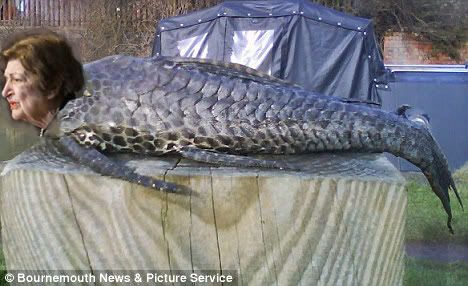
I think I see the video right there beside Bigfoot's head.
Posted on 06/10/2009 11:38:12 AM PDT by mnehring
A 55-year-old laboratory technician visiting Loch Ness has reportedly captured on video ‘the finest footage ever taken of the elusive mythical creature reputed to swim beneath the waters of Scotland’s most mysterious lake.’1,2
Gordon Holmes, from Yorkshire, UK, recalls the moment he sighted and videoed the creature:
‘I couldn’t believe my eyes when I saw this jet black thing, about 45 feet (15 metres) long, moving fairly fast in the water,’ he said. ‘My initial thought is it could be a very big eel, they have serpent-like features and they may explain all the sightings in Loch Ness over the years.’
Marine biologist Adrian Shine of the Loch Ness 2000 centre said of the video: ‘I see myself as a skeptical interpreter of what happens in the loch, but I do keep an open mind about these things and there is no doubt this is some of the best footage I have seen.’
There have been more than 4,000 purported ‘Loch Ness Monster’ sightings since the 1930s. Shine said that this video is particularly useful because Holmes panned back in order to include the background shore in some of the footage. Not only does that mean that the video was less likely to be a fake, it also provided a scale and geographical reference point, thus allowing an assessment of the creature’s size and speed.
However, the cloudiness of the lake’s water is such that it’s not clear whether the creature caught on video has
the plesiosaur-like features so often mentioned in reported sightings of large unexplained animals in various lakes in both the northern and southern hemispheres.
Most evolutionists are quick to dismiss any such references to plesiosaurs, as they insist such creatures vanished 65 million years ago, along with the dinosaurs.
However, contrast this with the Bible’s thousands-of-years timeframe for the true history of Earth. There’s really no basis for dismissing the possibility that plesiosaurs are not yet extinct.
After all, evolutionists had said the coelacanth, too, had been extinct for 65 million years, on the basis of their long-age interpretation of the ‘fossil record’. Yet the coelacanth is now known to be alive and well, with fishermen in African and Asian waters periodically hauling live specimens to the surface.
US researchers only recently began ‘the huge task of scanning every murky inch of Loch Ness’s rocky bottom’, reportedly hoping ‘to prove once and for all’ if the ‘Loch Ness monster’ really exists
The fact that the coelacanth and many other so-called living fossils are alive today is beautifully in line with the creationist interpretation of the ‘fossil record’. That is, it’s mostly a legacy of the global Flood of just a few thousand years ago (Genesis 6–9), reflecting the order of burial in that event. Contrast that with the evolutionists’ claim that it is a ‘record’ of the order of evolution (’appearance’) and extinction (’disappearance’) over hundreds of millions of years. Surely any rational person can see the creationist interpretation makes much more sense.
Just as it would have been wrong to say that the coelacanth was extinct because none had been found, similarly how can anyone claim that the plesiosaur is extinct just because none have been found? The world’s oceans are vast. Even today, after decades of oceanic surveys and research using the latest technology, previously unknown creatures of the deep are periodically brought to the surface in fishermen’s nets, or swim past the camera lenses of deep-water research probes, much to the surprise and delight of marine biologists.
In the Scottish loch itself, US researchers only recently began ‘the huge task of scanning every murky inch of Loch Ness’s rocky bottom’, reportedly hoping ‘to prove once and for all’ if the ‘Loch Ness monster’ really exists.3
As yet, there’s no sign of any ‘monster’ but the researchers have already made one very unexpected discovery, which highlights just how little we know about life in the deep waters (up to about 230 m (750 ft)) of the Loch.
At a depth of nearly 100 m (the reported figure was 324 ft) the sonar video fitted to a remotely operated underwater vehicle captured an image of ‘a Bufo bufo toad happily hopping along the loch’s ancient4 bed’.
Bufo bufo, widely known as the common toad, normally lives in shallow ponds—yet here it was, seemingly thriving 100 metres down. Scientists worldwide are said to be amazed at the discovery of an air-breathing insect-eating creature at such a depth.
Aberdeen University Professor John Watson commented, ‘This toad find was most unexpected—and we are now trying to establish how it can survive down there.’
‘This has given some of our team hope that the larger animals of Loch Ness may also still be alive and hibernating.’—Robert Rines, Leader of the US research team currently surveying Loch Ness.
Leader of the US research team, Robert Rines, said: ‘It was inexplicably and miraculously alive and active. The existence of this very much alive toad at this depth has excited and bewildered the scientific community. This has given some of our team hope that the larger animals of Loch Ness may also still be alive and hibernating.’
Larger animals? Such as an ‘elusive giant reptile’ perhaps? Indeed, the article in the Daily Mail reported that ‘the scientists believe that finding a toad at such depths means large reptiles could easily exist even deeper.’
Or perhaps even shallower, given the many ‘sightings’ of unidentified creatures/objects breaking the lake’s surface from time to time, the latest being the one captured on Gordon Holmes’s video footage.
Interestingly, British bookmakers William Hill are currently (mid-2007) offering odds of 250–1 that proof of the Loch Ness monster’s existence will be found.5 Yet
they recently slashed their odds for the discovery of extraterrestrial life down to 100–1 following the reported discovery of a potentially inhabitable extrasolar planet.6 In other words, they’re saying that discovering ‘Nessie’ is less likely than discovering alien life! Surely that is a measure of the extent to which evolutionary presuppositions have become mainstream in Britain (and elsewhere in the West), displacing what until recently had generally been a more biblically-centred worldview. (See Gary Bates’s article which explains why people who know and trust the Bible are able to resist popular notions about life on other planets.)
If, with the collection of more conclusive evidence over time, it turns out that a large aquatic reptile previously thought to have been extinct for millions of years is in fact still alive and well in the waters of Loch Ness, it will doubtless surprise many evolutionists. But it ought be no surprise for creationists. It will simply have become one more in a long list of (so-called) ‘living fossils’.
A-GAIN!!????
I forgot to add my disclaimer that by in posting this, I in no way endorse the content of the article.
I wants to beliefs.
But I’ll wait for the evidence.
I am not reading all that. Is the video online?
Too late.
I’m writing up a brutal flame of a post against you already.
Of course there isn’t.. the usual claim that someone, somewhere has something..
figures. Someone needs to set up 1,000 motion activated webcame around Loch Ness
“There’s really no basis for dismissing the possibility that plesiosaurs are not yet extinct.”
That’s murkier than Loch Ness.
Like oh so much of the rest of their stuff.

I think I see the video right there beside Bigfoot's head.
Hildabeast has been there again.

...
The Loch Ness Mobster?


and he is holding the baby of Loch Ness , what is that pink thing?
I was just being a sarcastic wisea$$!!
That describes me well. :->
Disclaimer: Opinions posted on Free Republic are those of the individual posters and do not necessarily represent the opinion of Free Republic or its management. All materials posted herein are protected by copyright law and the exemption for fair use of copyrighted works.